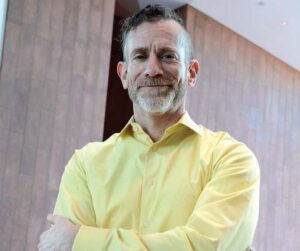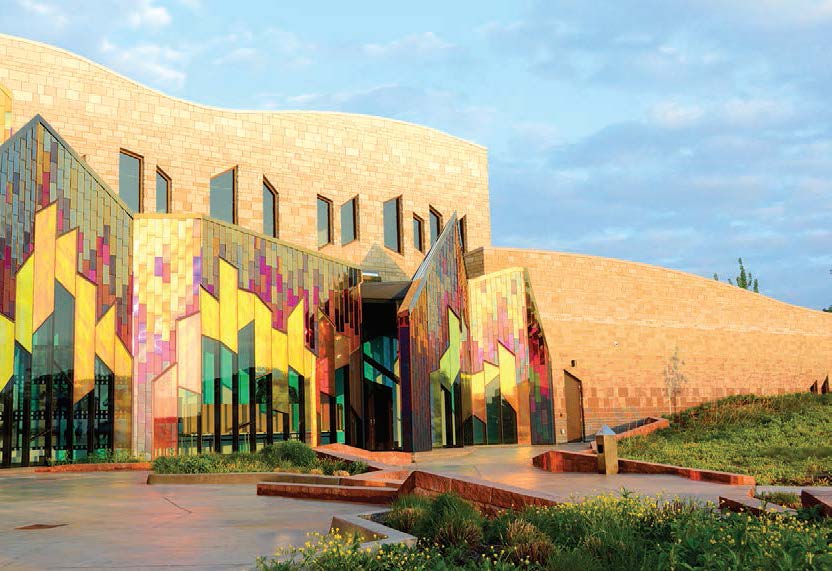Return to News
DESIGN PERSPECTIVE: THE MUSEUM AT PRAIRIEFIRE

Stone and Fire—Silver and Gold

Jonathan Kharfen, AIA LEED is a Principal at Boston-based Verner Johnson, Inc., which specializes in museum architecture and planning. He has been project architect and manager for four LEED certified projects: Flint Hills Discovery Center (Gold), Carnegie’s Museum of Natural History — Dinosaurs in Their Time (Silver), Tampa Bay History Center (Silver) and The Museum at Prairiefire (Silver).
Kharfen asserts that museums have always faced their own challenges in achieving LEED.
“High occupancies, strict temperature and humidity control and security and unique lighting concerns. But I think we’ve overcome many of these, especially with the development of LEED and new HVAC technologies.” – Jonathan Kharfen
His most recent LEED project, The Museum at Prairiefire, had both design and LEED-related challenges, but the result is an iconic work of art. The structure rises from the prairie to tell a story of geology, culture and the practice of prairie landscape management through intentional burns. Located in Overland Park, Kansas, with a population of close to 184,000, the museum is part of a landmark 60-acre mixed-use suburban development project. The focus is a rotation of exhibits from New York City’s American Museum of Natural History (AMNH).
The standout architectural marvel, with a stone-clad backdrop that represents the undulating hillside, is alive with fiery sparks of color which seem to flicker based on the time of day and viewing angle. Finding appropriate materials to evoke the flames, burnt landscape and charred remnants was Kharfen’s design challenge. He used an iridescent stainless steel product that subtly changes color depending on viewing angle and a cost-effective dichroic film manufactured by 3M, which he had laminated into a glazing unit. He then determined that a combination of stone—both natural limestone and man-made Cordova Stone™ veneer from Oldcastle’s Echelon Masonry—offered the range in terrain colors he was looking for. Four standard colors and two custom colors of Cordova Stone were used.
With a budget of $17.1 million, The Museum at Prairiefire has won acclaim with several awards for Verner Johnson, and achieved a LEED Silver rating. Kharfen explains an unexpected need to redesign the HVAC system likely prevented the museum from reaching their original goal of LEED Gold. “When the contractor started digging wells for the geothermal system, they came across undocumented pockets of natural gas, which forced us to abandon that system all together,” he says. “The alternate system was still efficient, but not nearly as efficient as the geothermal system, mainly because much of the building was already under construction.”
The LEED points were accumulated on many levels. On the exterior materials side, it was principally the sourcing of local Kansas Limestone (within 500 miles), the contribution of Echelon’s Cordova Stone veneer recycled content, steel recycled content, high albedo roofing, and the reduction of site waste during construction.
Kharfens’ design vision for the museum called for a massive 23,000 sq. ft. of exterior stone and working closely with D&D Masonry of Kansas City, the stone installer, the dream became a reality. “Stone, natural or manufactured, is a wonderful material,” he said. “It is durable, long-lasting, low maintenance, versatile, timeless and beautiful.” He adds, “Many manufactured masonry products are more durable and require less maintenance than some natural stones. They’re also more economical or at least comparable in price, and can be used in some circumstances where it would not be advised to use natural stone. In some cases, it might be more beneficial to use manufactured masonry products instead of stone due to their technical properties.”
Whereas larger institutions and new construction projects are a fairly easy sell on pursuing LEED, Kharfen said it can be a challenge to convince clients for smaller renovations, where budgets and schedules are tight, and where the benefits of LEED are not as tangible to them due to the very limited scope.
“As a firm, Verner Johnson has always strived to design energy efficient, long-lasting buildings, using durable, low-maintenance materials that are often regionally sourced,” he says.
“In addition, we always encourage our clients to pursue LEED certification, describing the benefits not only in terms of the environment, but economic benefits to the institution, functional benefits through the well-being of their employees, and overall social benefits vis-a-vis their patrons.” – Jonathan Kharfen
For Kharfen, LEED is always worth the pursuit. “Museums are stewards of culture, history and education,” he said. “They are highly regarded, trusted institutions that people look to as a window on the world around us,” says Kharfen. “It benefits this role of leadership in their community and in a broader context to pursue LEED. They then also become stewards of our environment and our future.”
Without a doubt, Kharfen’s LEED marvel, The Museum at Prairiefire, with its seamless blend of natural and man-made materials and kaleidoscope of colors against the exquisitely crafted stone backdrop, will serve as a living tribute to the prairie and will dazzle visitors for generations to come.
The Museum at Prairiefire achieved a LEED Silver rating.
This article was first featured in MODERN MASONRY Volume 2, Issue 1. Read the full issue here.

Return to News
Stay Connected
Get the latest news and information from Echelon by signing up to receive our monthly newsletter.